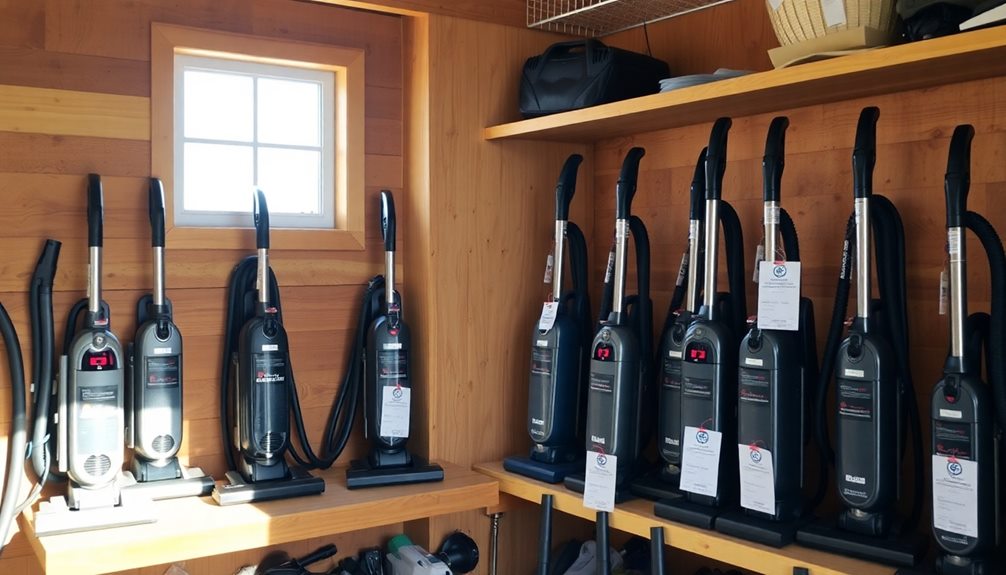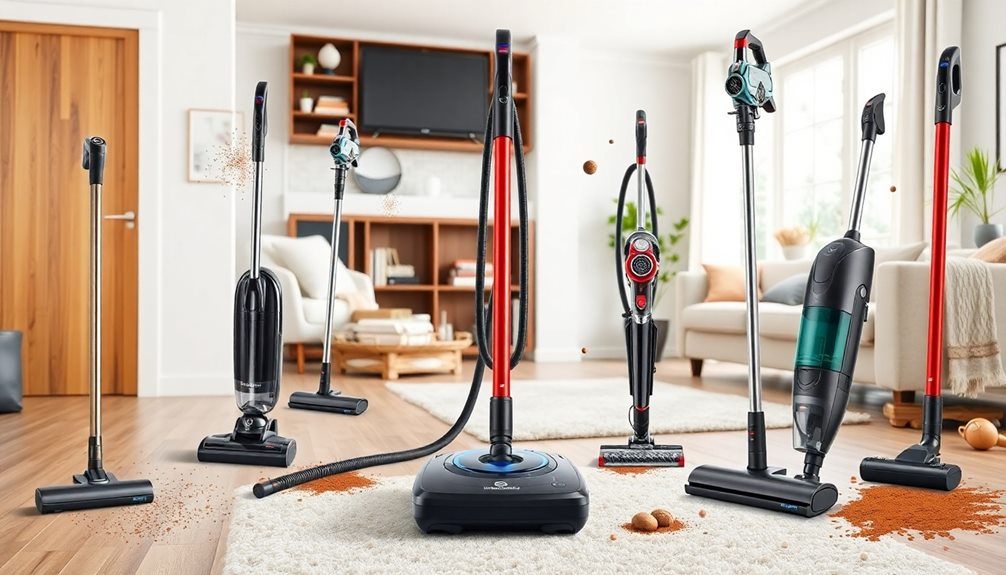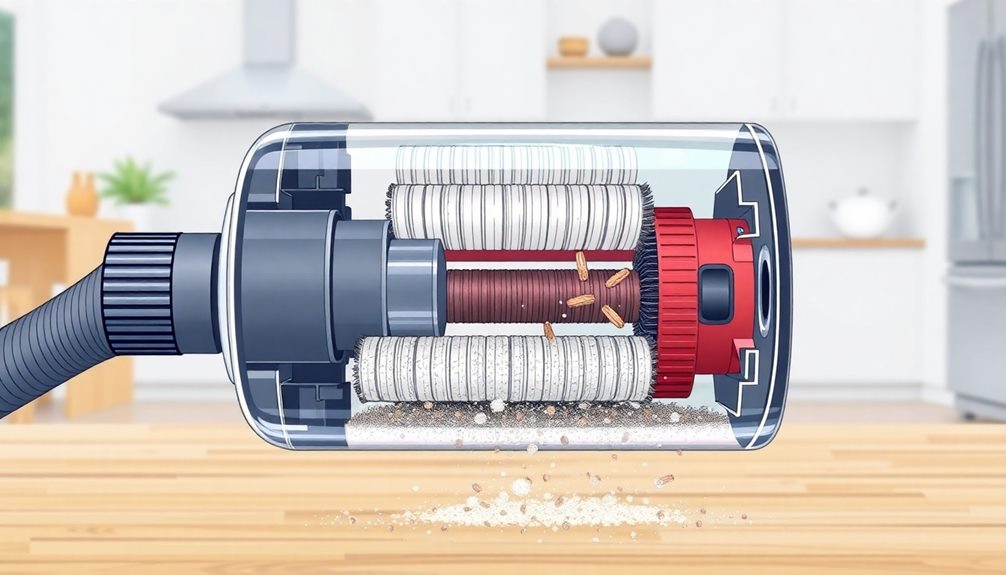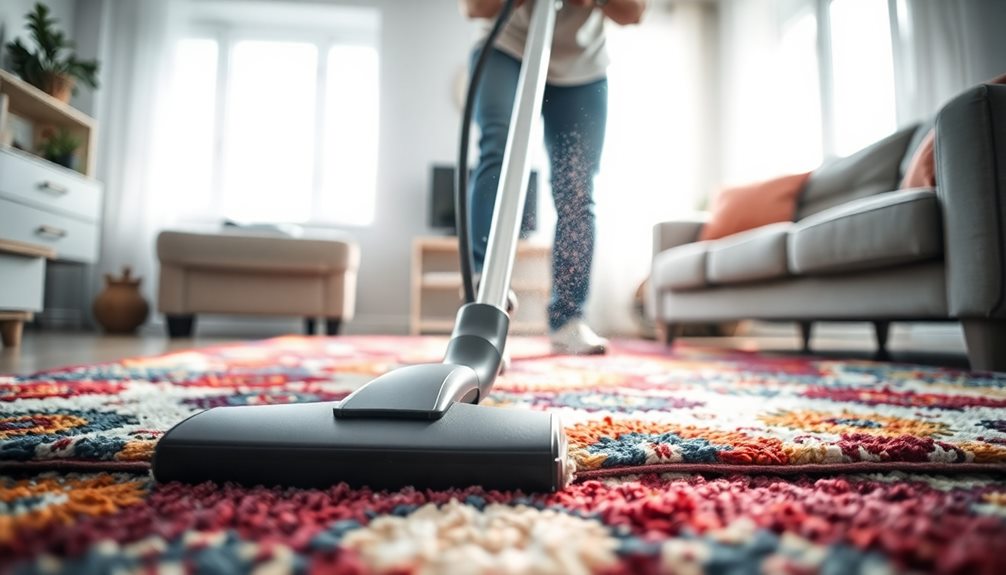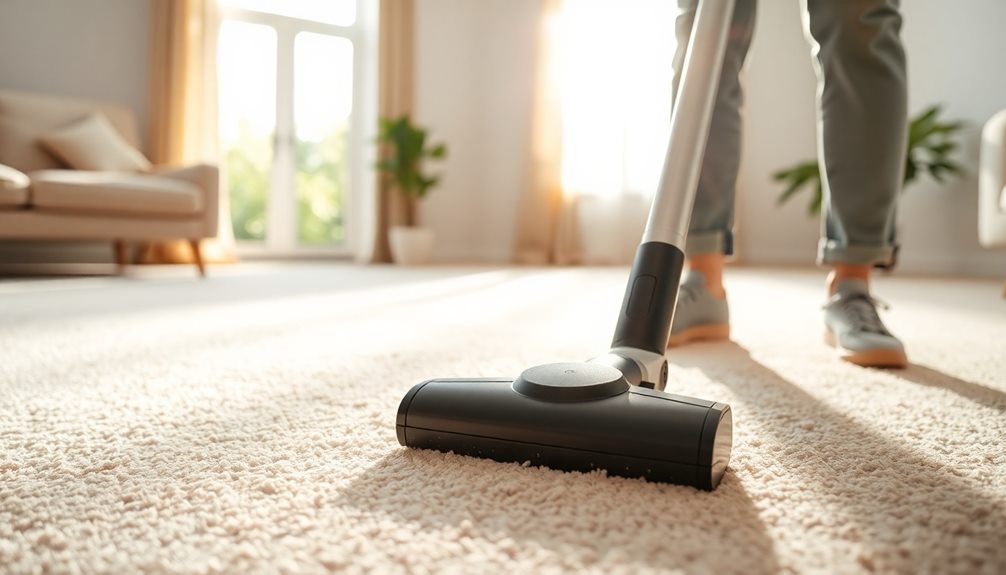To make your vacuum cleaner work effectively, start by ensuring the motor and fan are functioning properly, as they create the suction. Make sure to regularly clean or replace the filter to maintain airflow. Check for blockages in the hose and intake ports, and inspect the brush roll for tangles. Understanding your vacuum's type, whether it's upright, canister, or robotic, can also enhance usage efficiency. Don't forget to empty the dust container or bag when it gets two-thirds full. By following these tips, you can maximize performance and tackle any common issues like a pro. There's more to explore on keeping your cleaner in top shape!
Key Takeaways
- Ensure the vacuum cleaner is plugged in and powered on before use to activate the electric motor and suction mechanism.
- Select the appropriate attachments for different surfaces to enhance cleaning efficiency and maximize debris lift.
- Regularly clean or replace filters to prevent clogging and maintain optimal suction power throughout the vacuum's operation.
- Inspect the brush roll for tangles and debris, ensuring it rotates freely to effectively agitate dirt from carpets.
- Empty the dust container or replace the bag when it reaches two-thirds full to maintain strong suction performance.
Understanding Vacuum Cleaner Mechanics
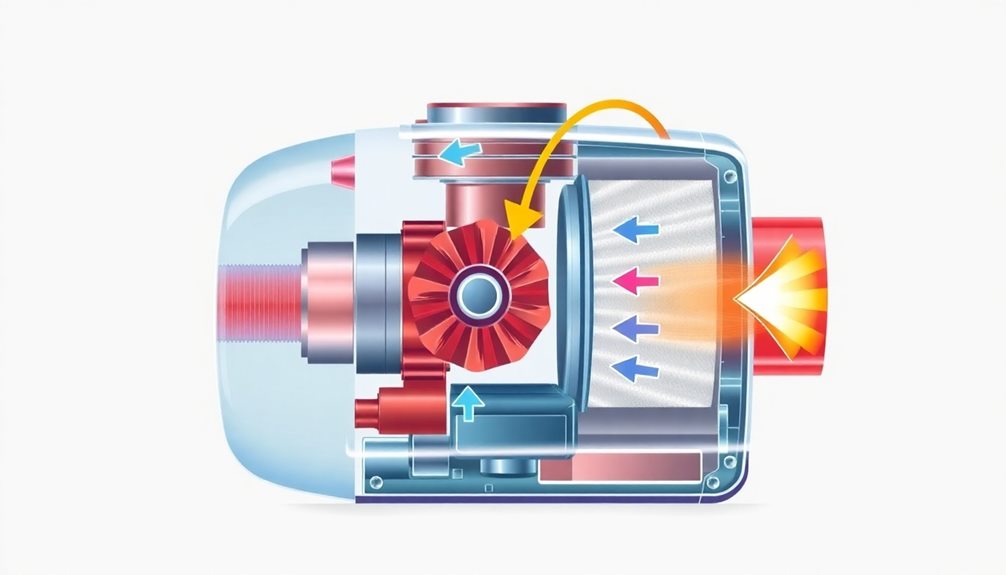
When you use a vacuum cleaner, it's fascinating to see how it works behind the scenes. At its core, an electric motor that spins creates the suction power you rely on. This motor drives a fan, generating a low-pressure area that pulls air and debris through the intake port.
As the fan blades rotate, they push ambient air into the vacuum, allowing dirt and particles to float along with it. The effectiveness of the suction that pulls debris relies heavily on the design of the intake port and the strength of the motor. Narrower attachments can increase airspeed, enhancing suction efficiency.
Many vacuum models come equipped with rotating brushes, which agitate dirt from carpets, making it easier for the suction mechanism to collect debris.
Once the dirt-laden air enters the vacuum, it passes through a filtration system or porous vacuum bag that traps the debris while allowing clean air to escape out the exhaust port.
This process not only keeps your environment clean but also guarantees that you're effectively collecting dirt, making your cleaning tasks more efficient. Understanding these mechanics can help you appreciate your vacuum cleaner even more!
Key Components of Vacuum Cleaners

Understanding the key components of vacuum cleaners can make a significant difference in how effectively you clean your home. The suction motor is the heart of your vacuum, operating at speeds of 30,000 to 35,000 RPM to create the necessary vacuum pressure for powerful cleaning.
This motor works in tandem with the brush roll, which features stiff bristles that agitate dirt in carpets, making it easier for the suction to lift debris. Additionally, best rated vacuums often incorporate advanced features for improved performance and ease of use.
You'll find that dust collectors come in two primary types: bagged and bagless. Bagged systems trap dirt in disposable bags, while bagless models use clear containers, allowing you to see when it's time to empty them.
Both systems rely on a robust filtration system, typically involving multi-stage filters that capture particles as small as 0.3 microns and release clean air back into your home.
Don't forget about the attachments! Each vacuum cleaner includes specific nozzles and tools designed for various surfaces and types of debris, enhancing your cleaning efficiency.
Types of Vacuum Cleaners
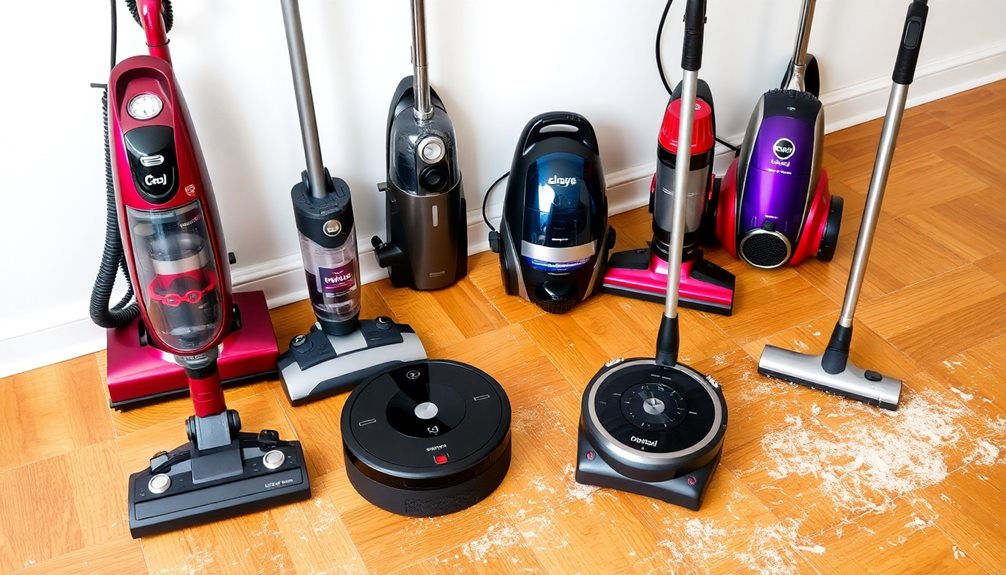
Choosing the right vacuum cleaner can greatly impact your cleaning routine. There are several types to evaluate, each with unique features tailored to different needs.
Upright vacuums are excellent for larger areas, providing powerful suction and rotating brushes that make carpet cleaning a breeze. On the other hand, canister vacuums shine in tight spaces and offer versatility, thanks to their compact design and multiple vacuum attachments for various cleaning surfaces.
If you prefer convenience, cordless vacuums are portable options that allow for quick clean-ups without the hassle of cords. However, keep in mind they usually have less suction power than corded models.
For a hands-free experience, robotic vacuums are a great choice, using sensors and smart technology to navigate your home. Just remember they might need regular maintenance to perform at their best.
Lastly, bagless models eliminate the need for bag replacements, utilizing clear containers that let you see dirt collection. They often incorporate centrifugal force to maintain suction efficiency.
How Suction Power Works

Suction power is the heart of a vacuum cleaner's effectiveness, and it primarily comes from an electric motor that spins a fan at high speeds, usually between 30,000 to 35,000 RPM. This rapid spinning creates a pressure difference, drawing air in through the intake port.
The design of the fan blades plays an essential role, as they not only pull air into the vacuum but also push it out through the exhaust port, establishing lower pressure inside the unit.
The size of the intake port greatly affects suction strength; narrower openings increase airspeed, enhancing suction force for more effective cleaning. Balance is key here—too much suction can hinder movement across surfaces, while too little will diminish cleaning effectiveness.
To maintain ideal suction power, you must regularly clean the filters and replace dust bags. Blockages in these areas can reduce airflow and efficiency, leading to less effective cleaning.
Maintenance Tips for Efficiency
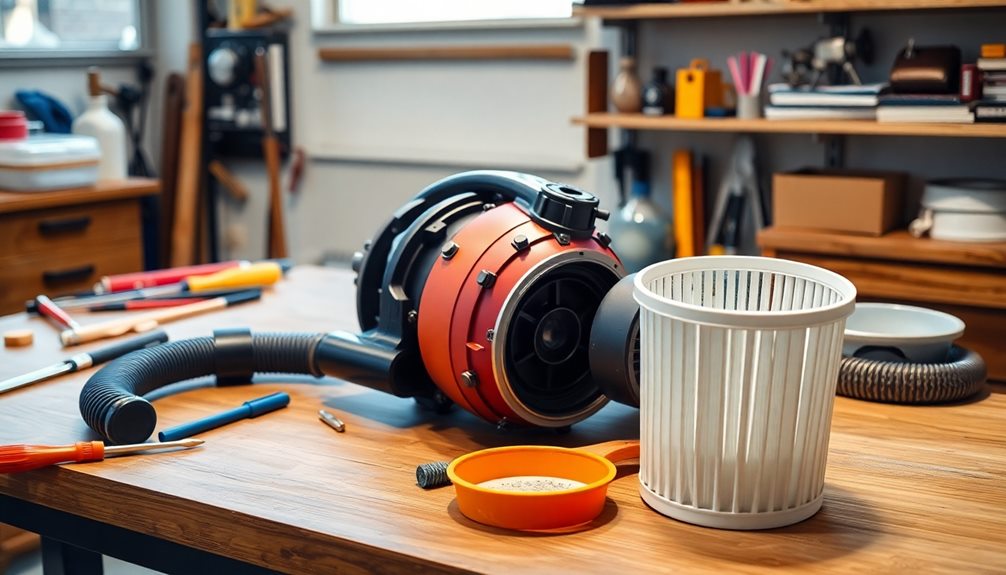
To keep your vacuum cleaner running efficiently, you need to regularly clean or replace the filters as recommended by the manufacturer.
Additionally, selecting a vacuum with advanced filtration systems, such as those found in the Best HEPA Filter Vacuums of 2024, can greatly improve your cleaning efficiency.
Don't forget to check for blockages in the hose and intake ports, since even small debris can considerably reduce suction power.
Regular Filter Cleaning
Maintaining your vacuum cleaner's filters is vital for optimal performance and efficiency. To achieve peak suction, you should regularly clean or replace your filters according to the manufacturer's guidelines. This practice prevents clogging, which can greatly reduce your vacuum's efficiency.
HEPA filters, designed to trap up to 99.97% of particles as small as 0.3 microns, should be washed or replaced every 6 to 12 months. This guarantees not only peak suction but also cleaner air output.
Additionally, foam or sponge filters can accumulate dust and debris quickly, impacting airflow and suction capability. Consequently, it's important to check and clean these filters frequently.
You should also remove and clean any pre-motor filters every few months to enhance performance and extend your vacuum cleaner's motor lifespan.
Before performing any filter maintenance, always make certain the vacuum is turned off and unplugged for your safety. By sticking to this maintenance routine, your vacuum will operate at its best, giving you the effective cleaning performance you need.
Check for Blockages
A vacuum cleaner's performance can quickly falter if blockages go unchecked. To maintain peak suction and airflow, it's essential to regularly check for any obstructions.
Here are four areas to inspect:
- Intake Port and Hose: Look for clogs or debris that could impede airflow and reduce suction efficiency.
- Brush Roll: Verify it's free from hair and tangles, as these can obstruct movement and hinder cleaning ability.
- Filters: Clean and check the filters according to the manufacturer's guidelines. Clogged filters can restrict airflow and cause overheating.
- Dust Bag or Container: Examine it and empty or replace it when it's about two-thirds full. This helps maintain peak suction power.
Don't forget to periodically inspect the exhaust port for blockages. Obstructions here can allow dirt to escape and negatively affect your vacuum's overall performance.
Importance of Filtration Systems

Filtration systems play an essential role in vacuum cleaners, greatly impacting both cleaning efficiency and indoor air quality. They're designed to trap dust and allergens, with HEPA filters being particularly effective—capable of capturing 99.97% of particles as small as 0.3 microns. This is vital for improving indoor air quality, especially for allergy sufferers and those with respiratory issues.
Effective filtration prevents harmful particles from being released back into your home, ensuring a cleaner environment. Many vacuum cleaners utilize multi-stage filtration processes, which capture larger debris first. This protects finer filters from clogging, maintaining your vacuum's suction power and overall cleaning effectiveness.
To achieve ideal performance from your vacuum cleaner, regular maintenance is key. Cleaning and replacing filters when necessary helps keep airflow unrestricted, preventing blockages that can diminish suction and efficiency.
Troubleshooting Common Issues
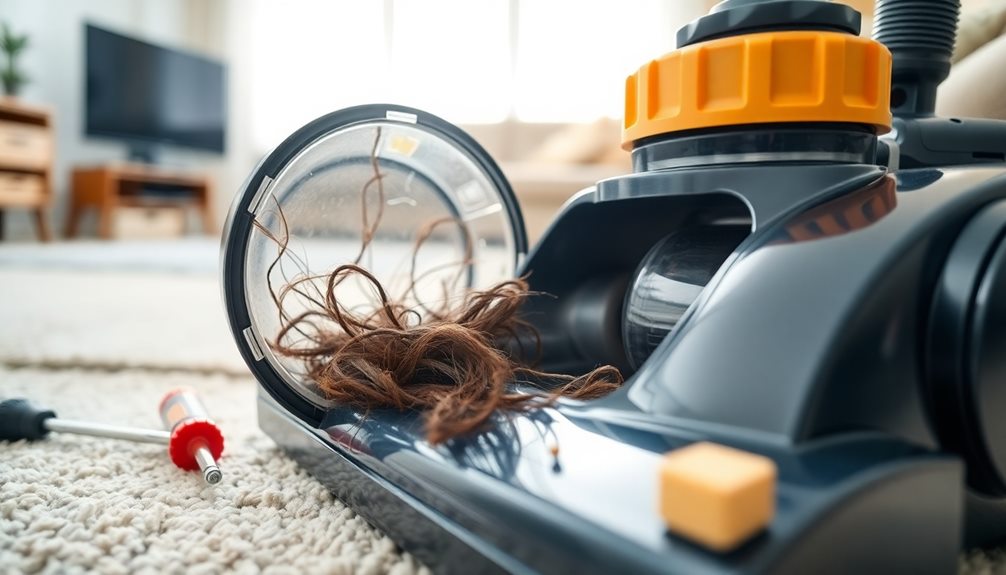
Keeping your vacuum cleaner in prime shape isn't just about having a good filtration system; it's also important to troubleshoot common issues that can arise during use. Here are some steps you can take to maintain peak performance:
- Check for Blockages: If you notice a loss of suction, inspect the hose and filters for any blockages. Clear them to enhance airflow.
- Clean the Brush Roll: Regularly remove hair and debris from the brush roll. Clogged brushes can impede rotation and reduce cleaning effectiveness.
- Empty the Dust Container: A full dust container or bag can drastically lower suction power. Make it a habit to check and empty it often.
- Address Overheating: If your vacuum is overheating, it's likely due to clogged filters or air passages. Clean these components to restore proper airflow.
For robotic vacuums, verify the charging station works correctly and that the sensors are clean to avoid navigation issues.
Frequently Asked Questions
Why Is My Vacuum Cleaner Not Working?
If your vacuum cleaner isn't working, check for clogs in hoses or filters. Make sure the dust container's empty, and inspect the motor. Regular maintenance can prevent these issues and help keep your vacuum running smoothly.
Why Is There No Suction in a Vacuum?
You notice the vacuum's silent struggle, but why's there no suction? Check for blockages, a full dust container, or a worn filter. Don't forget the motor; it might need some attention too. Keep it running strong!
How to Improve Suction on a Vacuum Cleaner?
To improve suction on your vacuum, regularly clean or replace filters, check for blockages, empty the bag or container when full, and use the right attachments for different surfaces. A well-maintained motor's essential too.
What Creates Suction in a Vacuum Cleaner?
When you release a vacuum cleaner's hidden power, it's the electric motor spinning a fan that crafts a gentle pull. This low-pressure zone invites dirt and dust to join the whirlwind, leaving your space sparkling clean.
Conclusion
In the end, keeping your vacuum cleaner in top shape is like nurturing a garden; with a little attention and care, it flourishes. Just as a wilted flower perks up with water and sunlight, your vacuum thrives on regular maintenance and clean filters. So, invest your time in understanding its mechanics and troubleshooting issues. You'll not only enhance its performance but also enjoy a cleaner home, making your efforts worthwhile. Remember, a little care goes a long way!




